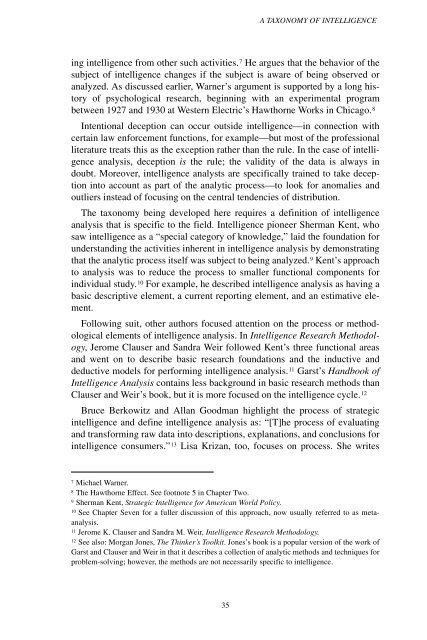Analytic Culture in the U.S. Intelligence Community (PDF) - CIA
Analytic Culture in the U.S. Intelligence Community (PDF) - CIA
Analytic Culture in the U.S. Intelligence Community (PDF) - CIA
Create successful ePaper yourself
Turn your PDF publications into a flip-book with our unique Google optimized e-Paper software.
A TAXONOMY OF INTELLIGENCE<br />
<strong>in</strong>g <strong>in</strong>telligence from o<strong>the</strong>r such activities. 7 He argues that <strong>the</strong> behavior of <strong>the</strong><br />
subject of <strong>in</strong>telligence changes if <strong>the</strong> subject is aware of be<strong>in</strong>g observed or<br />
analyzed. As discussed earlier, Warner’s argument is supported by a long history<br />
of psychological research, beg<strong>in</strong>n<strong>in</strong>g with an experimental program<br />
between 1927 and 1930 at Western Electric’s Hawthorne Works <strong>in</strong> Chicago. 8<br />
Intentional deception can occur outside <strong>in</strong>telligence—<strong>in</strong> connection with<br />
certa<strong>in</strong> law enforcement functions, for example—but most of <strong>the</strong> professional<br />
literature treats this as <strong>the</strong> exception ra<strong>the</strong>r than <strong>the</strong> rule. In <strong>the</strong> case of <strong>in</strong>telligence<br />
analysis, deception is <strong>the</strong> rule; <strong>the</strong> validity of <strong>the</strong> data is always <strong>in</strong><br />
doubt. Moreover, <strong>in</strong>telligence analysts are specifically tra<strong>in</strong>ed to take deception<br />
<strong>in</strong>to account as part of <strong>the</strong> analytic process—to look for anomalies and<br />
outliers <strong>in</strong>stead of focus<strong>in</strong>g on <strong>the</strong> central tendencies of distribution.<br />
The taxonomy be<strong>in</strong>g developed here requires a def<strong>in</strong>ition of <strong>in</strong>telligence<br />
analysis that is specific to <strong>the</strong> field. <strong>Intelligence</strong> pioneer Sherman Kent, who<br />
saw <strong>in</strong>telligence as a “special category of knowledge,” laid <strong>the</strong> foundation for<br />
understand<strong>in</strong>g <strong>the</strong> activities <strong>in</strong>herent <strong>in</strong> <strong>in</strong>telligence analysis by demonstrat<strong>in</strong>g<br />
that <strong>the</strong> analytic process itself was subject to be<strong>in</strong>g analyzed. 9 Kent’s approach<br />
to analysis was to reduce <strong>the</strong> process to smaller functional components for<br />
<strong>in</strong>dividual study. 10 For example, he described <strong>in</strong>telligence analysis as hav<strong>in</strong>g a<br />
basic descriptive element, a current report<strong>in</strong>g element, and an estimative element.<br />
Follow<strong>in</strong>g suit, o<strong>the</strong>r authors focused attention on <strong>the</strong> process or methodological<br />
elements of <strong>in</strong>telligence analysis. In <strong>Intelligence</strong> Research Methodology,<br />
Jerome Clauser and Sandra Weir followed Kent’s three functional areas<br />
and went on to describe basic research foundations and <strong>the</strong> <strong>in</strong>ductive and<br />
deductive models for perform<strong>in</strong>g <strong>in</strong>telligence analysis. 11 Garst’s Handbook of<br />
<strong>Intelligence</strong> Analysis conta<strong>in</strong>s less background <strong>in</strong> basic research methods than<br />
Clauser and Weir’s book, but it is more focused on <strong>the</strong> <strong>in</strong>telligence cycle. 12<br />
Bruce Berkowitz and Allan Goodman highlight <strong>the</strong> process of strategic<br />
<strong>in</strong>telligence and def<strong>in</strong>e <strong>in</strong>telligence analysis as: “[T]he process of evaluat<strong>in</strong>g<br />
and transform<strong>in</strong>g raw data <strong>in</strong>to descriptions, explanations, and conclusions for<br />
<strong>in</strong>telligence consumers.” 13 Lisa Krizan, too, focuses on process. She writes<br />
7<br />
Michael Warner.<br />
8<br />
The Hawthorne Effect. See footnote 5 <strong>in</strong> Chapter Two.<br />
9<br />
Sherman Kent, Strategic <strong>Intelligence</strong> for American World Policy.<br />
10<br />
See Chapter Seven for a fuller discussion of this approach, now usually referred to as metaanalysis.<br />
11<br />
Jerome K. Clauser and Sandra M. Weir, <strong>Intelligence</strong> Research Methodology.<br />
12<br />
See also: Morgan Jones, The Th<strong>in</strong>ker’s Toolkit. Jones’s book is a popular version of <strong>the</strong> work of<br />
Garst and Clauser and Weir <strong>in</strong> that it describes a collection of analytic methods and techniques for<br />
problem-solv<strong>in</strong>g; however, <strong>the</strong> methods are not necessarily specific to <strong>in</strong>telligence.<br />
35
















